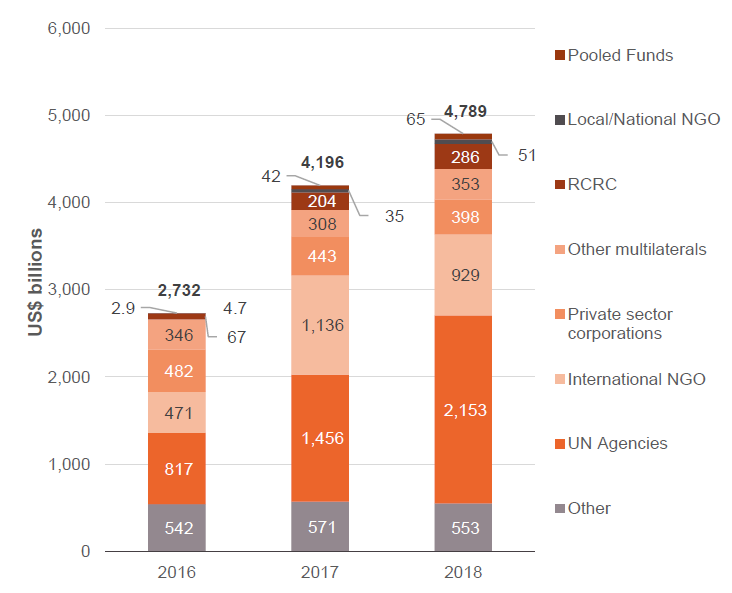Multi-year humanitarian funding: Global baselines and trends: Chapter 6
Recipient organisations of funding
DownloadsFigure 5: Donors’ reported multi-year humanitarian contributions are largely directed to international organisations

Multi-year humanitarian contributions reported by donors between 2016 and 2018 were largely directed to international organisations, namely UN agencies and international NGOs. The share of funding to these recipients grew between 2016 and 2018. In 2016, of 2,732 billion US dollars reported funding, 817 US billion dollars were directed to UN agencies and 417 billion US dollars to international NGOs. In 2018, of 4,789 billion US dollars of reported funding, 2,153 billion US dollars were directed to UN agencies and 929 billion US dollars to international NGOs.
Source: Development Initiatives based on data provided bilaterally and from the International Aid Transparency Initiative (IATI). Data was collected between April and August 2019.
Notes: The dataset shown in the chart covers 11 institutional donors that are Grand Bargain signatories and reported to DI's survey. Multi-year funding also refers to funding agreements ranging between 12 and 24 months when defined as multi-year by the donor. “Other” includes academia/think tanks, government agencies, other multilaterals and undefined organisations. RCRC: International Red Cross and Red Crescent Movement. UK Department for International Development data was collected from IATI and includes some technical operation costs. Data is in constant 2017 prices.
Donors’ multi-year humanitarian grants have so far been channelled in the same way as total international humanitarian assistance [1] , being primarily directed to international responders, namely UN agencies and international NGOs.
- UN agencies received the largest portion of donors’ reported multi-year humanitarian contributions between 2016 and 2018. Multi-year grants to UN agencies grew over this period by volume – from US$817 million to US$2.1 billion – and as a proportion of the total, from 30% to 45%.
- International NGOs represent the second largest recipients of donors’ multi-year grants. Their share of total humanitarian contributions increased at a slower pace than UN agencies’, from 17% (US$471 million) in 2016 to 19% (US$929 million) in 2018.
- Among all other first-level recipients, international aid organisations received 77% (US$3.7 billion) of donors’ multi-year contributions in 2018, an increase of 15% on 2016 levels (US$1.7 billion). The private sector received 8% (US$398 million) of the total multi-year humanitarian funding in 2018, while 12% (US$553 million) went to undefined recipients.
- Multi-year contributions to local and national NGOs were 11 times higher in 2018 than in 2016, while for pooled funds, they were more than 20 times higher. Despite these increases, their respective share of multi-year funding remained low, at 1% of the total for each.
Downloads
Notes
-
1
Development Initiatives, Global Humanitarian Assistance report 2019. Available at: /publications/global-humanitarian-assistance-report-2019/Return to source text